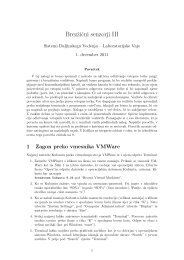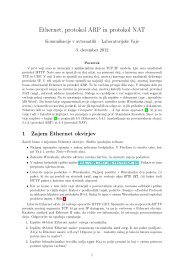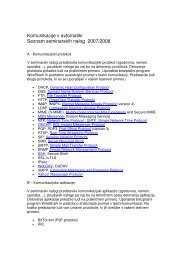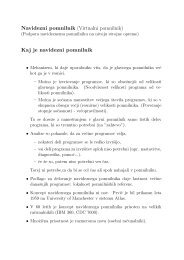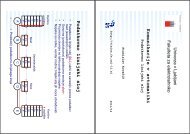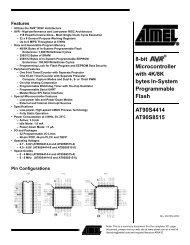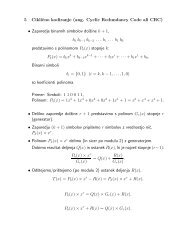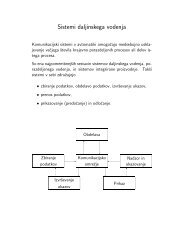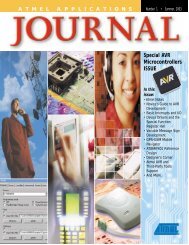AVR Instruction Set Nomenclature: Status Register (SREG ...
AVR Instruction Set Nomenclature: Status Register (SREG ...
AVR Instruction Set Nomenclature: Status Register (SREG ...
You also want an ePaper? Increase the reach of your titles
YUMPU automatically turns print PDFs into web optimized ePapers that Google loves.
LD (LDD) - Load Indirect From data space to <strong>Register</strong> using Index Z<br />
<strong>Instruction</strong> <strong>Set</strong><br />
Description:<br />
Loads one byte indirect with or without displacement from the data space to a register. For parts with SRAM, the data<br />
space consists of the register file, I/O memory and internal SRAM (and external SRAM if applicable). For parts without<br />
SRAM, the data space consists of the register file only. The EEPROM has a separate address space.<br />
The data location is pointed to by the Z (16 bits) pointer register in the register file. Memory access is limited to the current<br />
data segment of 64K bytes. To access another data segment in devices with more than 64K bytes data space, the RAMPZ<br />
in register in the I/O area has to be changed.<br />
The Z pointer register can either be left unchanged by the operation, or it can be post-incremented or pre-decremented.<br />
These features are especially suited for stack pointer usage of the Z pointer register, however because the Z pointer register<br />
can be used for indirect subroutine calls, indirect jumps and table lookup, it is often more convenient to use the X or Y<br />
pointer as a dedicated stack pointer. Note that only the low byte of the Z pointer is updated in devices with no more than<br />
256 bytes data space. For such devices, the high byte of the pointer is not used by this instruction and can be used for<br />
other purposes. The RAMPZ register in the I/O area is updated in parts with more than 64K bytes data space, and that the<br />
displacement is added to the entire 24-bit address on such devices. For devices with more than 64K bytes program memory<br />
and up to 64K bytes data memory, the RAMPZ register is only used by the ELPM and ESPM instructions. Hence,<br />
RAMPZ is not affected by the ST instruction.<br />
For using the Z pointer for table lookup in program memory see the LPM and ELPM instructions.<br />
The result of these combinations is undefined:<br />
LD r30, Z+<br />
LD r31, Z+<br />
LD r30, -Z<br />
LD r31, -Z<br />
Using the Z pointer:<br />
Operation: Comment:<br />
(i) Rd ← (Z) Z: Unchanged<br />
(ii) Rd ← (Z) Z ← Z + 1 Z: Post increment<br />
(iii) Z ← Z -1 Rd ← (Z) Z: Pre decrement<br />
(iiii) Rd ← (Z+q) Z: Unchanged, q: Displacement<br />
Syntax: Operands: Program Counter:<br />
(i) LD Rd, Z 0 ≤ d ≤ 31 PC ← PC + 1<br />
(ii) LD Rd, Z+ 0 ≤ d ≤ 31 PC ← PC + 1<br />
(iii) LD Rd, -Z 0 ≤ d ≤ 31 PC ← PC + 1<br />
(iiii) LDD Rd, Z+q 0 ≤ d ≤ 31, 0 ≤ q ≤ 63 PC ← PC + 1<br />
75




